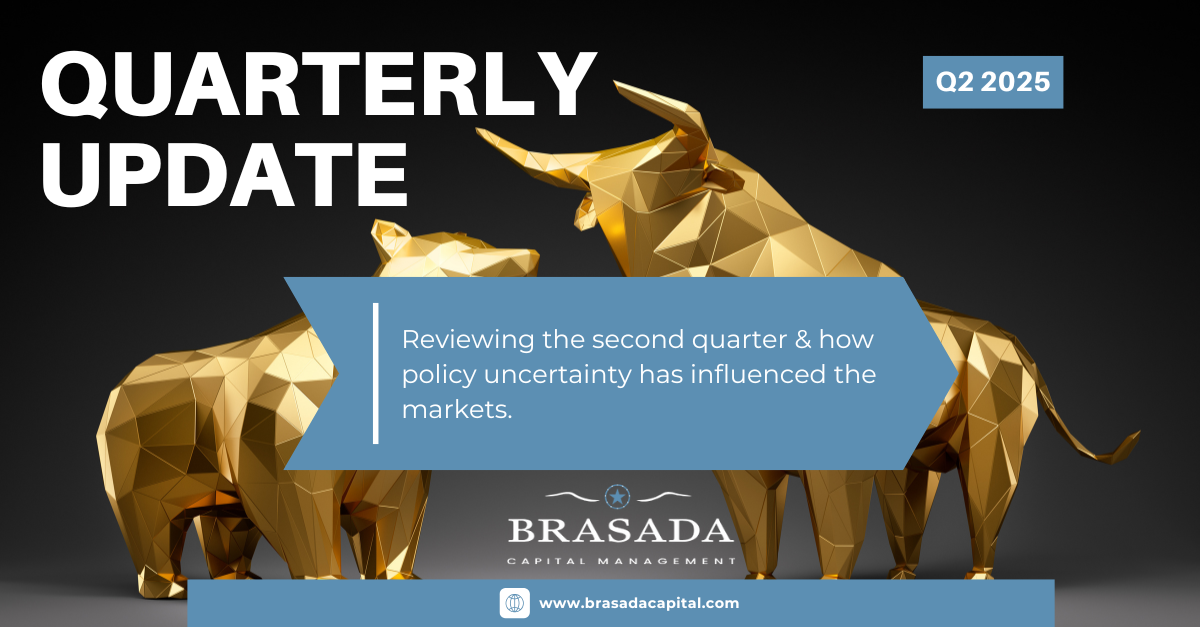Second Quarter of 2025
“Far more money has been lost by investors preparing for corrections or trying to anticipate corrections than has been lost in corrections...

“The less prudence with which others conduct their affairs, the greater the prudence with which we should conduct our own affairs.” – Warren Buffett
“Risk control is invisible in good times but still essential, since good times can so easily turn onto bad times.” – Howard Marks
Passive Perils: The Magnificent Seven
We believe that a low-cost, passive investing strategy such as an S&P 500 index fund has a place in our industry – after all, for most retail investors who cannot invest the time, nor have the expertise, nor the experience, then investing in a highly diversified ‘market’ portfolio is probably the best course of action. Said another way, it is better to own 500 stocks that you know nothing about than to own just 1 stock that you also know nothing about.
The problem, however, is that much of the professional investing industry has taken this initial concept of passive investing and used it as an excuse to forgo any active investment responsibility at all – shifting their business models away from one dependent on investment performance and towards one dependent on sales-based asset gathering. As such, it is not uncommon in our industry to come across firms where sales professionals outnumber investment professionals by 10-to-1.
We at Brasada take a different approach. We truly believe that owning a concentrated portfolio of high-quality companies at attractive prices is the most durable and consistent path to long-term, risk-adjusted returns. Said another way, we believe it is best to own 30 stocks that we know inside and out than a basket that includes our 500th best idea.
The advantages of such an approach are often most noticeable at market extremes. Consider that a prudent, long-term investment strategy will not simply chase momentum in the same way passive funds do. Instead, when markets are overly optimistic, or overly pessimistic, an active strategy will respond accordingly. This should mean short-term performance divergence (both under and over) with the market, with the goal being to maximize long-term, after-tax returns through the time-arbitrage approach we discussed in our last article.
We bring this up today because the biggest story in the stock market over the past few years has been the increasing dominance of just a handful of massive technology companies on market level returns – Apple, Microsoft, Alphabet, Amazon, Meta Platforms, Nvidia, and Tesla. We are now starting to see evidence of increasing risks in the larger market indices due to this significant concentration in higher-valuation technology names.
For some context, the trailing 1-year performance of the S&P 500 as of first quarter end was 29.88%. Compare that to the equal-weighted S&P 500 return over the same period at just 19.42%. The difference between the two numbers is entirely from the concentration effect mentioned above. Today, nearly 30% of the 500-stock index is weighted towards just 7 similar bets. Concentration levels are nearing a 60-year high. This increasing risk isn’t apparent to many.
How do Passive Indexes get into these situations? Well, long-story short, passive isn’t really all that passive. For starters, there is a committee that actively decides what gets included and what doesn’t in these indexes (you might recall a lot of uproar when they decided to include Tesla, which is arguably still an unprofitable company save for tax credits). Then, there is the issue of passive investors making the active choice to buy and sell their holdings, often at the worst possible time – chasing bull markets and selling bear markets.
But most importantly, is the fact that passive investing is, above all else, an exercise in price momentum. Stocks where their share price is rising (regardless of fundamentals) will be bid up and weighed higher in a passive based system, and vice versa for stocks where the share price is falling.
What is the problem? This concentration has been working so far, the past few years, hasn’t it? Charlie Munger, who sadly passed away earlier this year, had a great saying, “there is no better teacher than history in determining the future.” If we look to history, we will find that over longer periods of time the largest names in the index tend to underperform. This is nothing other than math – the larger a business is, the harder it is to move the needle on growth.
For further evidence from history, consider the start of the 1980s when it seemed like IBM would be the clear winner going forward, or the start of the 1990s when it was clear that investing in Japan was right choice, or the beginning of the 2000s when Microsoft and Intel’s PC monopoly dominated the market, or the beginning of the 2010s when the BRICs, led by China, was thought to be the best choice for investment dollars. In each decade, the only certainty was that whatever the current investment fad was would fall way to a new one in a few years’ time – often with a lot of pain for investors that bought into the hype at the top.
What is the current fad that is being predicted to dominate the future? AI. You will likely have read about or tried out the new ChatGPT product from OpenAI. The importance of ChatGPT’s launch was not so much in the technology itself (Large Language Models have been around for a while albeit not publicly) but in how it was packaged in a way that made the technology actionable and relatable to almost everyone – artists, students, business executives, etc. ChatGPT was the first product that gave us a glimpse of the utility we might gain as a society as this technology is refined and perfected.
However, as has been true with each paradigm-shifting technology that came before – the personal computer, the internet, smartphones, social media, etc. – markets tend to get ahead of themselves in bidding up every possible winner, despite history showing time and again that early winners in these revolutions (Macintosh PC, Yahoo, Blackberry, MySpace, etc.) are rarely the same winners a decade later (Windows PC, Google, iPhone, Facebook, etc.) not to mention the disruption to older industries that are displaced by these new technologies entirely.
The most important thing to remember regarding these “revolutionary technology” narratives we hear about in the media is that you can accurately predict that a technology will be revolutionary and still lose a lot of money betting on it as an investor – just look to the history of the automotive or airline industries. The better strategy is to continue looking at businesses on a case-by-case basis, focusing investment dollars solely where there is high confidence in what earnings power will be a decade from now regardless of whatever happens with this AI revolution.
In conclusion, we believe that to embrace the passive indexes at today’s concentration levels would require a strong belief in one of the largest money losing ideas in history: “This time is different.”

“Far more money has been lost by investors preparing for corrections or trying to anticipate corrections than has been lost in corrections...
.png)
UNDERSTANDING TARIFFS: ECONOMIC IMPACT, RATIONALE AND CONTROVERSIES
%20(3).png)
Market Selloff Dear Clients and Friends, Thursday and Friday marked the 4th time in the last 50 years when the S&P 500 had a 2-day drop of over...